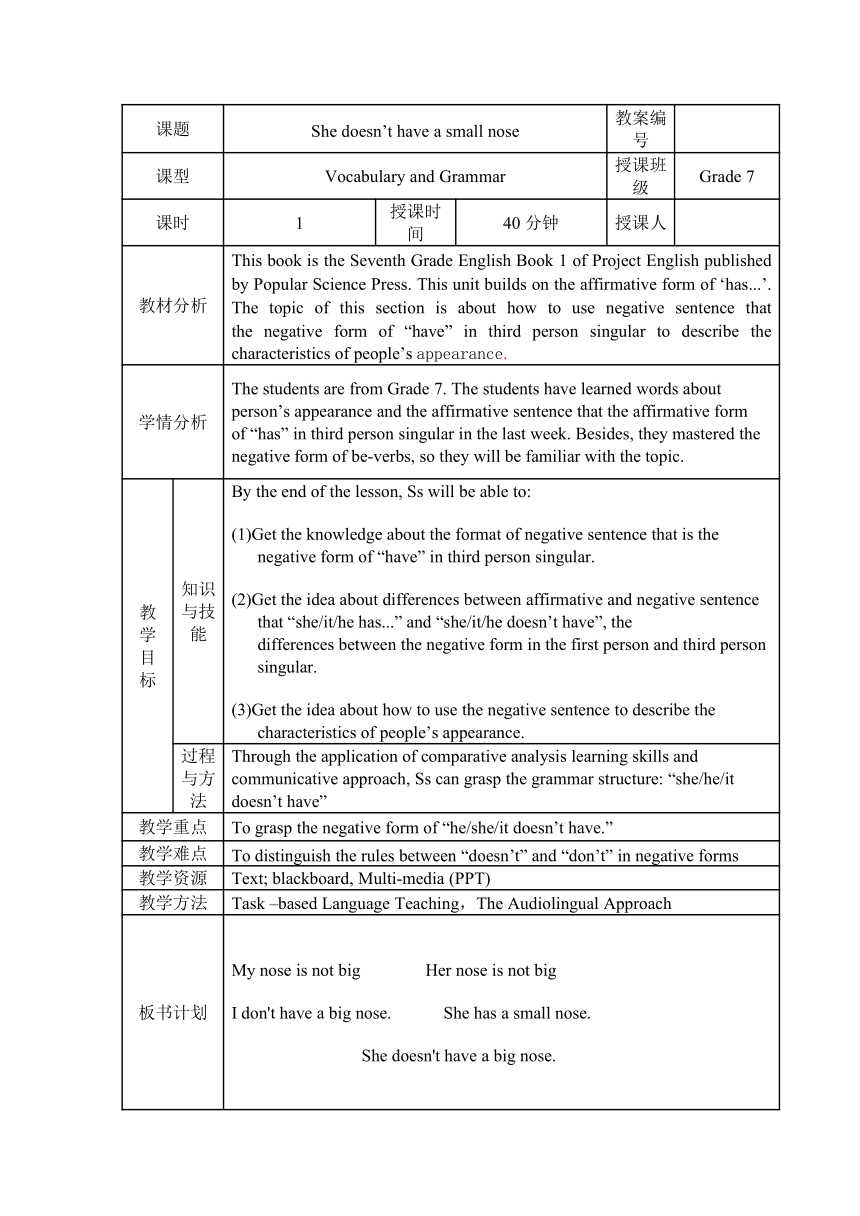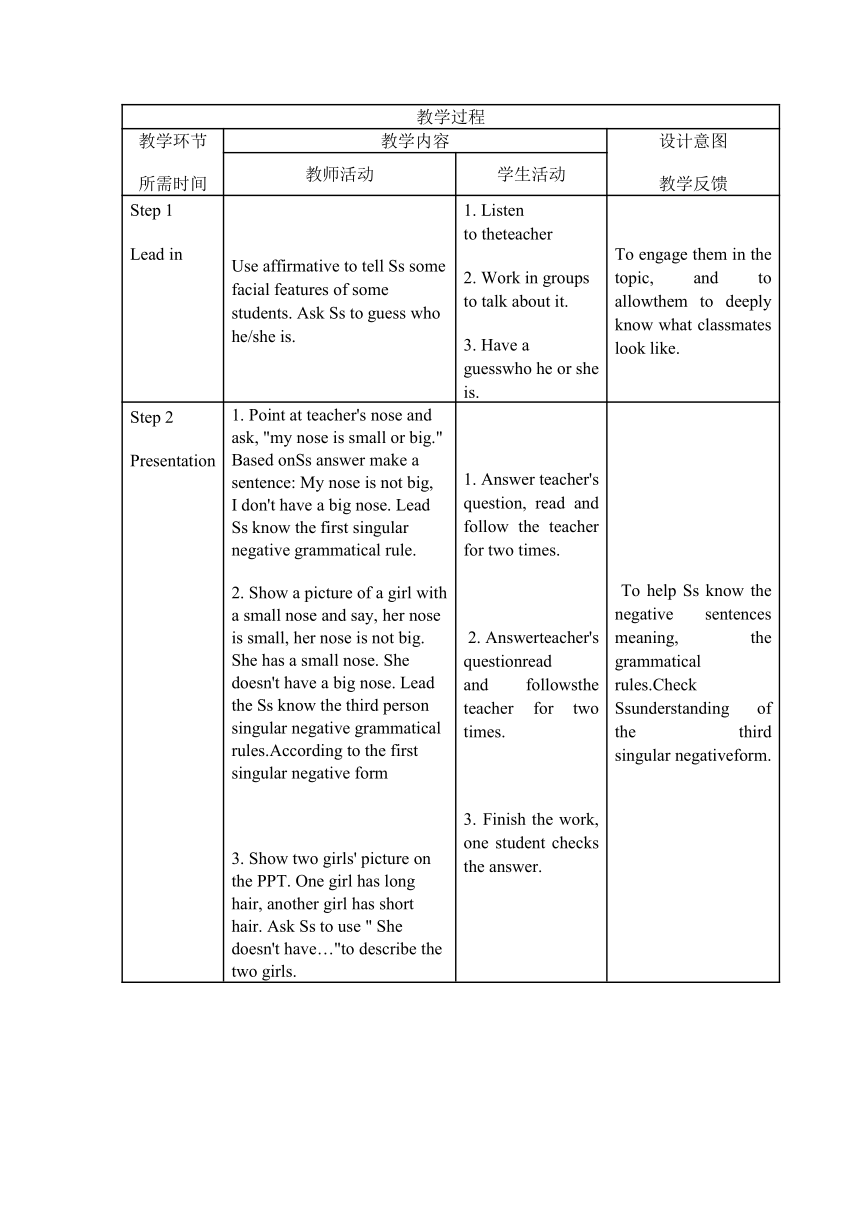人教版七下 Unit 9 Section A She doesn't have a big nose. Vocabulary and Grammar 教案(表格式)
文档属性
| 名称 | 人教版七下 Unit 9 Section A She doesn't have a big nose. Vocabulary and Grammar 教案(表格式) |  | |
| 格式 | zip | ||
| 文件大小 | 18.1KB | ||
| 资源类型 | 教案 | ||
| 版本资源 | 人教新目标(Go for it)版 | ||
| 科目 | 英语 | ||
| 更新时间 | 2022-08-11 15:24:45 | ||
图片预览


文档简介
课题 She doesn’t have a small nose 教案编号
课型 Vocabulary and Grammar 授课班级 Grade 7
课时 1 授课时间 40分钟 授课人
教材分析 This book is the Seventh Grade English Book 1 of Project English published by Popular Science Press. This unit builds on the affirmative form of ‘has...’. The topic of this section is about how to use negative sentence that the negative form of “have” in third person singular to describe the characteristics of people’s appearance.
学情分析 The students are from Grade 7. The students have learned words about person’s appearance and the affirmative sentence that the affirmative form of “has” in third person singular in the last week. Besides, they mastered the negative form of be-verbs, so they will be familiar with the topic.
教学目标 知识与技能 By the end of the lesson, Ss will be able to: (1)Get the knowledge about the format of negative sentence that is the negative form of “have” in third person singular. (2)Get the idea about differences between affirmative and negative sentence that “she/it/he has...” and “she/it/he doesn’t have”, the differences between the negative form in the first person and third person singular. (3)Get the idea about how to use the negative sentence to describe the characteristics of people’s appearance.
过程与方法 Through the application of comparative analysis learning skills and communicative approach, Ss can grasp the grammar structure: “she/he/it doesn’t have”
教学重点 To grasp the negative form of “he/she/it doesn’t have.”
教学难点 To distinguish the rules between “doesn’t” and “don’t” in negative forms
教学资源 Text; blackboard, Multi-media (PPT)
教学方法 Task –based Language Teaching,The Audiolingual Approach
板书计划 My nose is not big Her nose is not big I don't have a big nose. She has a small nose. She doesn't have a big nose.
教学过程
教学环节 所需时间 教学内容 设计意图 教学反馈
教师活动 学生活动
Step 1 Lead in Use affirmative to tell Ss some facial features of some students. Ask Ss to guess who he/she is. 1. Listen to theteacher 2. Work in groups to talk about it. 3. Have a guesswho he or she is. To engage them in the topic, and to allowthem to deeply know what classmates look like.
Step 2 Presentation 1. Point at teacher's nose and ask, "my nose is small or big." Based onSs answer make a sentence: My nose is not big, I don't have a big nose. Lead Ss know the first singular negative grammatical rule. 2. Show a picture of a girl with a small nose and say, her nose is small, her nose is not big. She has a small nose. She doesn't have a big nose. Lead the Ss know the third person singular negative grammatical rules.According to the first singular negative form 3. Show two girls' picture on the PPT. One girl has long hair, another girl has short hair. Ask Ss to use " She doesn't have…"to describe the two girls. 1. Answer teacher's question, read and follow the teacher for two times. 2. Answerteacher's questionread and followsthe teacher for two times. 3. Finish the work, one student checks the answer. To help Ss know the negative sentences meaning, the grammatical rules.Check Ssunderstanding of the third singular negativeform.
3.Practice Practice1 Give several sentence. Ask student to change them into negative form or affirmative form. These sentences have different subjects. Practice2 A game. Teacher uses severalnegative form sentences to describe a person. 1. Ss need to change sentences into negative form or affirmative form separately. 2. Two students need to paint it on the blackboard according to they heard. The rest of them will compare two pictures whether they are same. 1. Students can get a better understanding of main sentence structure in this unit and grammar. 2. They can know how to describe a person indaily communication. Practice 3. To improve their listening.
Step 4 Production Ask Ss to observe the appearance of their desk mate, and describe each other with the words they have learned. Then choose several groups to speak out the sentences (or words ), with other Ss check whether the sentences are true or false. 1 Listen to the teacher's requirement, and work with the desk mate to describe their appearance with the sentences they've learned (speak out). 2. Listen to the sentences made by the Ss picked out by Ts and find out whether they are true or false (correct it). To check Ss' deeper understanding of the sentences and practice their speaking and listening skills for the details.
课堂小结
课堂检测
教学效果 自我评估: ⑴教学任务完成情况 ⑵学生掌握情况
作业
课后反思 改进设想
课型 Vocabulary and Grammar 授课班级 Grade 7
课时 1 授课时间 40分钟 授课人
教材分析 This book is the Seventh Grade English Book 1 of Project English published by Popular Science Press. This unit builds on the affirmative form of ‘has...’. The topic of this section is about how to use negative sentence that the negative form of “have” in third person singular to describe the characteristics of people’s appearance.
学情分析 The students are from Grade 7. The students have learned words about person’s appearance and the affirmative sentence that the affirmative form of “has” in third person singular in the last week. Besides, they mastered the negative form of be-verbs, so they will be familiar with the topic.
教学目标 知识与技能 By the end of the lesson, Ss will be able to: (1)Get the knowledge about the format of negative sentence that is the negative form of “have” in third person singular. (2)Get the idea about differences between affirmative and negative sentence that “she/it/he has...” and “she/it/he doesn’t have”, the differences between the negative form in the first person and third person singular. (3)Get the idea about how to use the negative sentence to describe the characteristics of people’s appearance.
过程与方法 Through the application of comparative analysis learning skills and communicative approach, Ss can grasp the grammar structure: “she/he/it doesn’t have”
教学重点 To grasp the negative form of “he/she/it doesn’t have.”
教学难点 To distinguish the rules between “doesn’t” and “don’t” in negative forms
教学资源 Text; blackboard, Multi-media (PPT)
教学方法 Task –based Language Teaching,The Audiolingual Approach
板书计划 My nose is not big Her nose is not big I don't have a big nose. She has a small nose. She doesn't have a big nose.
教学过程
教学环节 所需时间 教学内容 设计意图 教学反馈
教师活动 学生活动
Step 1 Lead in Use affirmative to tell Ss some facial features of some students. Ask Ss to guess who he/she is. 1. Listen to theteacher 2. Work in groups to talk about it. 3. Have a guesswho he or she is. To engage them in the topic, and to allowthem to deeply know what classmates look like.
Step 2 Presentation 1. Point at teacher's nose and ask, "my nose is small or big." Based onSs answer make a sentence: My nose is not big, I don't have a big nose. Lead Ss know the first singular negative grammatical rule. 2. Show a picture of a girl with a small nose and say, her nose is small, her nose is not big. She has a small nose. She doesn't have a big nose. Lead the Ss know the third person singular negative grammatical rules.According to the first singular negative form 3. Show two girls' picture on the PPT. One girl has long hair, another girl has short hair. Ask Ss to use " She doesn't have…"to describe the two girls. 1. Answer teacher's question, read and follow the teacher for two times. 2. Answerteacher's questionread and followsthe teacher for two times. 3. Finish the work, one student checks the answer. To help Ss know the negative sentences meaning, the grammatical rules.Check Ssunderstanding of the third singular negativeform.
3.Practice Practice1 Give several sentence. Ask student to change them into negative form or affirmative form. These sentences have different subjects. Practice2 A game. Teacher uses severalnegative form sentences to describe a person. 1. Ss need to change sentences into negative form or affirmative form separately. 2. Two students need to paint it on the blackboard according to they heard. The rest of them will compare two pictures whether they are same. 1. Students can get a better understanding of main sentence structure in this unit and grammar. 2. They can know how to describe a person indaily communication. Practice 3. To improve their listening.
Step 4 Production Ask Ss to observe the appearance of their desk mate, and describe each other with the words they have learned. Then choose several groups to speak out the sentences (or words ), with other Ss check whether the sentences are true or false. 1 Listen to the teacher's requirement, and work with the desk mate to describe their appearance with the sentences they've learned (speak out). 2. Listen to the sentences made by the Ss picked out by Ts and find out whether they are true or false (correct it). To check Ss' deeper understanding of the sentences and practice their speaking and listening skills for the details.
课堂小结
课堂检测
教学效果 自我评估: ⑴教学任务完成情况 ⑵学生掌握情况
作业
课后反思 改进设想
同课章节目录
- Unit 1 Can you play the guitar?
- Section A
- Section B
- Unit 2 What time do you go to school?
- Section A
- Section B
- Unit 3 How do you get to school?
- Section A
- Section B
- Unit 4 Don't eat in class.
- Section A
- Section B
- Unit 5 Why do you like pandas?
- Section A
- Section B
- Unit 6 I'm watching TV.
- Section A
- Section B
- Review of Units 1-6
- Unit 7 It's raining!
- Section A
- Section B
- Unit 8 Is there a post office near here?
- Section A
- Section B
- Unit 9 What does he look like?
- Section A
- Section B
- Unit 10 I'd like some noodles.
- Section A
- Section B
- Unit 11 How was your school trip?
- Section A
- Section B
- Unit 12 What did you do last weekend?
- Section A
- Section B
